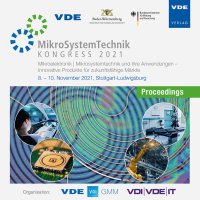Optimization of a High-g Acceleration Sensor for Crash-test Application
Conference: MikroSystemTechnik Kongress 2021 - Kongress
11/08/2021 - 11/10/2021 at Stuttgart-Ludwigsburg, Deutschland
Proceedings: MikroSystemTechnik Kongress 2021
Pages: 4Language: englishTyp: PDF
Authors:
Srivastava, Ananya; Rockstroh, Jan (Hahn-Schickard-Gesellschaft, Villingen-Schwenningen, Germany)
Dehe, Alfons (Hahn-Schickard-Gesellschaft, Villingen-Schwenningen, Germany & Georg H. Endress Chair for Smart System Integration, Department of Microsystems Engineering – IMTEK, Albert-Ludwigs-University Freiburg, Freiburg, Germany)
Abstract:
Piezoresistive accelerometers are a popular and widely used method of acceleration sensing due to their simplicity in fabrication, packaging and inherent ruggedness. These devices usually have simpler electronics for example compared to capacitive sensors. There are products available without ASICs as well. [1] This work takes an existing high-g piezoresistive accelerometer as a reference sensor and works on optimizing this design. The work delves into different design and optimization techniques to deliver novel high-performance piezoresistive acceleration sensor prototypes. These techniques exploit the device physics and mechanics to point towards the new designs. The sensor is designed and optimized to have higher bandwidth. The adaptation of SOI wafers instead of currently used epitaxial wafers, results in smaller chip size, enabling more chips/wafer and reducing the sensor cost. Extra emphasis has been laid to maintain high sensitivity, for specified doping of the piezoresistors, while still not compromising much on the resonance frequency. Finite element analysis with ANSYS Workbench offers insights into the device performance and helps in the determination of some key sensor parameters for the new designs. It also helps to establish trends and this provides an idea for the successive models. After several iterations and incorporating different optimization techniques, new models are achieved.


